Island House, Laugharne
Island House is a Grade II* listed, partly Tudor, sub-medieval town house located in Laugharne, Carmarthenshire, in south west Wales. Sitting below the castle with its frontage ranged along Wogan Street between the River Corran and a former mill stream, Island House is the oldest residence still standing in the township and has a listing status indicating a building of exceptional interest.[2] The historical importance of the whole site is also reflected by separate Grade II listings of its garden, [3] walls,[4] and outbuildings.[5]
| Island House, Laugharne | |
|---|---|
 Island House, Laugharne in 1856 [1] | |
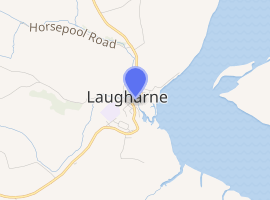
| |
| General information | |
| Coordinates | 51.7696°N 4.4634°W |
Listed Building – Grade II* | |
| Official name | Island House |
| Designated | 1986 |
| Reference no. | 9671 |
Principally built of stone, the oldest parts date from the 15th century, with later additions from the 16th and 19th centuries. The first owners may well have traded goods that were brought into and out of the adjacent Gosport Harbour, which could shelter 350-ton vessels at that time.[6]. Laugharne was a thriving seaport for many centuries [7] before its capability to support navigation slowly diminished as siltation of the Tâf estuary inexorably reduced the tidal prism after the early 1600s.[8]
History
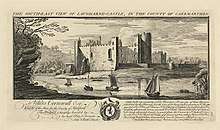
The first record of ownership is for Elizabeth White in 1584, widow of Thomas Rhys ap Rhydderch of Hawksbrook, Llangynog.[9] She was the heiress of Jasper White of Laugharne, whose family held land in Laugharne from the 14th century and may have been the original builders of Island House. [10]
The subsequent owners of the house have been researched in some detail.[11] They included members of influential noble families such as Vaughan of Golden Grove and Mansel of Margham along with the volatile County High Sheriff in 1608, Rhys Prydderch of Laugharne, son of Jasper White's great grandson. His son James' successor, Zacharias Thomas of Trefenty, moved into Island House just before the Lordship of Laugharne was sold to Sir William Russell, who sided with the Royalist cause in the Wars of the Three Kingdoms. In 1664 the adjacent castle was subject to heavy bombardment and Island House sustained significant collateral damage as a result. An unwelcome reward for its then occupant if Mary Curtis was right about his Parliamentarian sympathies.
‘Island House, a most ancient and interesting one, is near the castle; its walls in some parts as thick as those of the castle. The projecting part of it is properly the middle of the house; the other half, extending on the other side of it, was destroyed by accident by the cannon-balls fired on the castle by Cromwell’s soldiers. At that time a partisan of his was living in the house; and a small part of the half now extending out from the other side of the projecting part, was destroyed; one of the balls was preserved in the house up to 1823.’[12]
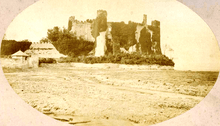
At that time it was occupied by George Stacpoole and owned by Mr & Mrs Wienholt (Mary Abra Hughes Skyrme)
A date of 1658 is engraved into the lintel of the yard door, indicating some rebuilding having taken place at this time, perhaps reconstruction following the Civil War damage. Curtis also recounts the traditions of a subterranean passage connecting to the castle and of a 'priest hole' hidden inside the structure which, if true, might have been inserted at this time. It may equally be of an earlier date, such refuges were built throughout the period of religious persecution in the 16th and 17th centuries when the ap Rydderch family occupants were known to be Catholics.[13]
A recent study has shown by comparison of three separate historical surveys that Island House was passed down, via a series of wealthy and often powerful owners, as a constituent part of the estate originally held by James Prydderch in 1595. [14] This group of properties remained virtually intact throughout, although was further enlarged over time. Almost all of Prydderch’s township burgage plots, whilst it is not possible to determine their exact locations, were owned two hundred and fifty years later by the final prominent nineteenth-century resident, Mary Abra Hughes Skyrme (1818-85). [11] For a time Wogan Street was known locally as 'Chandler's Hill' after three generations of the Skyrme family traded marine supplies from the property. [15] Three of them were elected Portreeves and Mary was the last of its line in Laugharne: "The 1871 census shows her in Island House, married to Frederick Wienholt and with a resident dressmaker, two domestic servants, and a coachman/groom. We can gain a glimpse of the grand life at this time in scraps from her accounts book for 1835/6. [16] They included taking a sedan chair one evening to an assembly at The Globe (about 100 metres up the road from her house!). It was probably in her time that the subsidiary rear service wings were added to the house." [17]
Present day
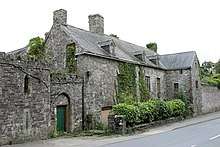
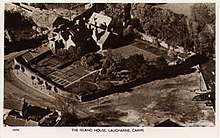
Census returns from 1881-1911 show that the property continued to provide a prestigious, 20-room home for well-to-do families in Laugharne up to and including the inter-war years. Even after the period of economic recession and profound social change that followed WW1, two full-time gardeners were still employed by the retired Indian Army major, Claude Vivyan Congreve, who took up residence at the turn of the century and died in 1923. His widow Mary, an accomplished musician, was responsible for organising monthly dances and indeed most of the town's entertainment between the wars according to her neighbour Lt Colonel R.A.Tucker, whose mother had accompanied the family when they moved to Laugharne from London. [18] Caleb Rees, Deputy Chief Inspector of Schools for Wales, lived in the property from 1943 until his death in 1970. [19]
The later twentieth century was not so kind to the buildings, which steadily deteriorated. After the owner died in 2004 it remained empty and has lain more or less derelict in recent times. Safety concerns led the County Council to apply for a Compulsory Purchase order in 2015 after several years on the 'at risk' register.[20] In 2019 a public campaign was launched to save Island House, by then on the brink of serious collapse, [21] which resulted in its acquisition by new owners. [22]
References
- Jones 1997, p. 98.
- "Island House, Laugharne, Carmarthenshire". britishlistedbuildings.co.uk.
- "Island House, Garden, Llaugharne". Commisiwn Brenhinol Henebion Cymru. Retrieved 1 August 2020.
- "Boundary Wall to Island House". British Listed Buildings - History in Structure. Retrieved 1 August 2020.
- "Garage to Island House, Laugharne, Carmarthenshire". britishlistedbuildings.co.uk.
- Gosport Harbour, Laugharne
- Taylor 2009, p. 215.
- Read 1997.
- Jones 1937, p. 340.
- Meyrick 1846, p. 129.
- Stopp 2017.
- Curtis 1880, p. 92.
- Randall 1997, p. 64.
- (1) Survey of the Lordship of Laugharne, 1595. Laugharne Corporation; (2) Laugharne Corporation Survey 1835, Laugharne Corporation; (3) Tithe Map of Laugharne Parish 1842. NLW
- Tyler 1925, p. 52.
- Eyre Evans 1937, p. 29.
- Stopp 2017, p. 41.
- Tucker 1988, p. 20.
- James, M.A. (2001). REES, Caleb (1883 - 1970), inspector of schools and author. Dictionary of Welsh Biography. Retrieved 6 August 2020.
- "Residents fight to save Laugharne's Island House building". bbc.co.uk.
- Thomas, Bethan (22 May 2020). "In an abandoned, crumbling Tudor building in the heart of Laugharne". walesonline.
- "Building of the Month May 2020: Island House, Laugharne, Carmarthenshire". www.savebritainsheritage.org.
External links
Sources
- Jones, Francis (1997). "Island House". Historic Carmarthenshire Homes & Their Families (2nd ed.). Brawdy Books. p. 98. ISBN 0952834413.
A fine sketch of the house, made in 1856, was produced in Curtis
CS1 maint: ref=harv (link) - Taylor, Duncan (2009). The Maritime Trade of the Smaller Bristol Channel Ports in the Sixteenth Century (PDF) (Thesis). University of Bristol. pp. 168–215. Retrieved 1 August 2020.CS1 maint: ref=harv (link)
- Read, Simon; van Veele, Thomas (2017). "The Geomorphology of the River Taf Estuary as a Context for the Evolution of the Community of Laugharne".CS1 maint: ref=harv (link)
- Stopp, Peter (2017). "Island House". The Carmarthenshire Antiquary. 53.CS1 maint: ref=harv (link)
- Meyrick, S.R.(ed.) (1846). Lewys Dwnn: Heraldic Visitations of Wales 1586-1613. London: Longman. p. 129.CS1 maint: extra text: authors list (link) CS1 maint: ref=harv (link)
- Curtis, Mary (1880). The Antiquities of Laugharne, Pendine & Their Neighbourhoods (2nd ed.). London: R.Clay. p. 167. Retrieved 26 July 2020.CS1 maint: ref=harv (link)
- Jones, Francis (1967). "The Society of Sea Serjeants". Trans.Hon.Society of Cymmrodorion. 53: 342.CS1 maint: ref=harv (link)
- Howell, David W. (1986). Patriarchs and Parasites:The Gentry of S.W. Wales in the Eighteenth Century. UWP. p. 20.CS1 maint: ref=harv (link)
- Williams, E.V. (1963). History of Laugharne Corporation: Charter & Portreeves. Narberth & Tenby: H.G.Walters. p. 5.CS1 maint: ref=harv (link)
- Jones, Francis (1937). "The Squires of Hawksbrook". Trans. Hon. Society of Cymmrodorion. 53: 342.CS1 maint: ref=harv (link)
- Randall, Alan (1997). "Recusancy in Carmarthenshire". The Carmarthenshire Antiquary. XXXIII: 64.CS1 maint: ref=harv (link)
- Thomas, Spencer (1970). "The Descent of the Lordships of Laugharne and Eglwyscummin: Norman Marcher Lordships in South-West Carms". The Carmarthenshire Antiquary. 6: 42.CS1 maint: ref=harv (link)
- Tyler, R. H.; et al. (1985) [1925]. Laugharne: Local History and Folklore. Llandysul: Gomer Press. p. 52. ISBN 9780863831546.CS1 maint: ref=harv (link)
- Tucker, J.A.G. (1988). Yesteryear: Laugharne in the Inter War Years. UWP. p. 20.CS1 maint: ref=harv (link)
- Will of John Hughes NLW SD/1729/86
- Will of Samuel Hughes, NLW SD/1732/21
- Will of Zacharias Thomas, Gent., NLW SD/1681/60